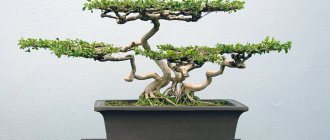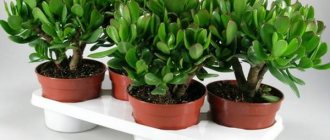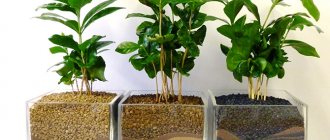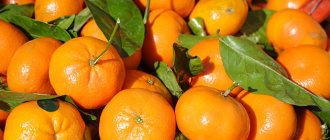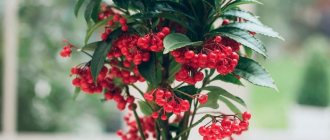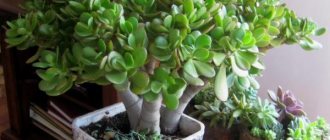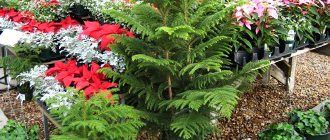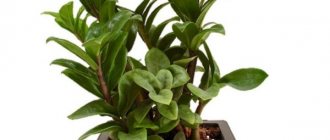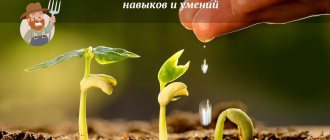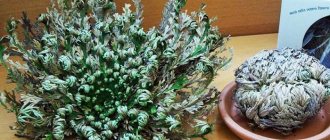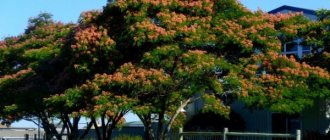Sofya Slavyanskaya Decided to plant acacia at the dacha
Last summer, my friend and I were walking through the park and came to an alley lined with trees completely covered with bright pink flowers. The spectacle was amazing! I decided to plant such a tree near my house. From the photos in the reference books I found out that this is a sticky Robinia (lat. Robinia viscosa Vent). I studied the rules of planting and care. I share information here.
Pink acacia is widely used for landscaping city parks, alleys and gardens.
Albizia - silk acacia
Albizia attracts attention with its bright flowers, reminiscent of exotic acacia flowers. In our gardens we grow Albizia Lankaran , which is sometimes called silk acacia. Those who have ever vacationed in Crimea have probably seen an elegant shrub on the Black Sea coast, which locals call coastal “mimosa.”
Park albizia with a dense umbrella crown is popular in all tropical and subtropical countries. It is very similar to a real acacia: the same double-pinnate leaves and fluffy flowers, in which very long stamens stand out. In our climate, these beautiful deciduous plants prefer to be kept in tubs. In the south of the republic, one of the umbrella acacias - Albizia Lankaran - is widely grown in open ground. It can be distinguished from the Caucasian acacia (silver “mimosa”) only by its flowers, since it has the same finely dissected feathery leaves. And only when the adult plant puts on its soft pink outfit, and in the summer, and not at the end of winter, like the “mimosa”, the mistake becomes obvious: we have albizia.
Indeed, albizia flowers have very long staminate filaments, which, depending on the variety, can be white, pink or red, which makes them highly decorative.
Albizia Lankaran is a large deciduous tree 10-12 meters high. It has a spreading umbrella-shaped crown, like some types of tropical acacias. Albizia leaves are lacy, dissected into many small lobes. According to some scientists, the birthplace of this plant is Lankaran (a city in Azerbaijan).
Lenkoran shrub is a plant of a dry, warm climate, but even in the coldest winters for our conditions, the albizia is not damaged. Apparently this is due to climate change. The only thing that has remained unchanged is that Albizia is light-loving and cannot grow in the shade of other trees.
Albizia begins to leaf out late, at the end of May, when almost all the trees have already blossomed. Albizia blooms profusely and for a long time - from mid-June until September-October, depending on the weather. In autumn, it retains its leaves for a very long time (sometimes until the end of November), which few trees in our climate are capable of. Albizia remain green until the last moment, and can only be destroyed by sudden frosts.
Albizia propagates by seeds, cuttings, and root shoots. But albizia seeds require “hot” stratification. To do this, the seeds are soaked for 5-6 hours in hot water (+60 C), after which they are sown. You can also use the usual “cold” stratification, which the seeds undergo in winter right in the ground. When sowing in autumn, seed germination in spring is about 80%, and single seeds can sprout within a year. In the first year, Albizia seedlings grow slowly and by autumn they rarely reach a height of 20 cm. You should not feed them at this time: you can burn the roots of young plants. In addition, with an excess of nitrogen fertilizers, the growing season of plants is delayed, and the wood of seedlings may not ripen well by winter. Then, during severe frosts, the plants can suffer greatly. You can start feeding albizia seedlings from the second year of life, gradually increasing the dosage.
Vegetative propagation of albizia is used more often. Some trees produce root shoots that can be separated and transplanted when the plants are dormant. Yes, and Lenkoran acacia is cut satisfactorily: you can use both lignified and green cuttings.
Lignified cuttings are cut from the previous year's annual growths. Cuttings with 2-3 buds are taken from the middle of the shoot, treated with root formation stimulants and planted in a permanent place in loose, fertile soil. After 3-4 months, rooting usually occurs by 70-80%.
Many acacias are grown as ornamental trees. Albizia is perfect for creating spectacular hedges, undergrowth and alleys. Sometimes used as a tapeworm. The main economic purpose is landscaping, securing slopes, and constructing windbreaks.
Planting and caring for Albizia
Pittosporum tobira plant description, care and diseases, watering and propagation
Tree
It is best to plant trees in spring, May or early summer, when the soil is sufficiently warm. When planting in the fall, the plant will need additional protection; it is also necessary to choose the location carefully: if the acacia is in a cold or overly wet place, its roots may be damaged and begin to rot.
Before planting, you need to dig several deep holes at a distance of 2.5-3 meters from each other - the roots of Robinia develop well and occupy a significant area. The depth must be sufficient for the entire length of the tree, otherwise the taproot will not be able to develop normally.
At the bottom of the hole you need to pour a layer of small stones or crushed stone for drainage, then fill the rest of the area with a mixture of 3 parts turf, 2 parts sand and 2 parts compost. When planting, it is necessary to ensure that the root collar is not buried. Afterwards, the tree is watered abundantly and, if necessary, mulched with peat - this will help retain moisture and prevent the roots from freezing or overheating.
During June and July, it is necessary to regularly feed the seedlings with a solution of manure (part manure to 5 parts water) or bird droppings (part litter to 20 parts water). When Robinia grows and becomes strong enough, it will need regular complementary feeding with ready-made complex fertilizers.
Acacia does not like to have its roots disturbed, and therefore does not require loosening the soil. The same applies to pruning branches: you can remove shoots damaged by frost only after the robinia has flowered.
In the first three years for the winter, the trunk of the white acacia must be insulated with burlap or spruce paws, the roots are covered with dry leaves or peat.
It is important to note that acacia is practically not susceptible to diseases, but insect attacks can harm it. Its worst enemies are aphids, mealybugs and bagworms.
They can harm leaves and young shoots - the consequences of their attacks can be seen in the photo. To prevent this, you will need to regularly inspect the crown, cut off damaged branches and burn them. Trees should be treated with poisons after flowering, so as not to harm the bees and spoil the honey.
An ordinary miracle
Maria Yurasova, AiF. At the dacha”: Grigory Aleksandrovich, do you have any examples of successful cultivation of trees and shrubs that were previously considered unstable in central Russia?
– Personally, I don’t have many “crazy” examples of my own. I am a cautious person, I try not to take risks. In my work, I always rely on information that I was able to obtain in advance, and I approach the matter with a certain hope of success. But in my department there are employees who have a completely different approach - adventurous. And I welcome it, because thanks to this they are doing a lot of interesting things. For example, we have swamp cypress growing here. He is over 10 years old and has already grown 7 meters. It definitely shouldn't have survived here since the tree is native to Florida. But nevertheless it grows! There are several Lawson Cypress trees that tend to die in our climate. They suffered for a long time, but still survived, survived the extreme winter of 2006, and I hope that they will continue to live. This is real luck. Another “crazy thing” is Paulownia pubescent - a native of the subtropics of China. It lives, grows and simply shocks everyone with its huge leaves and incredible annual growth. And of course, our magnolias. Some of them are already regularly flowering and bearing fruit.
– What is the main reason that such plants, which are exotic for us, have been growing and blooming for many years now - the correct agricultural technology or, after all, the special microclimate of Moscow University?
– Both matters. But agricultural technology, of course, comes first. And not just its observance, but a person’s approach to the plant. Kind attitude, caring. Thanks to this, not only correct agricultural technology is born, but also a certain information exchange takes place between man and plant, in which I firmly believe. Without any mysticism and obscurantism. The plant, figuratively speaking, simply begins to “understand” what they want from it. Although the microclimate, of course, is also important.
– To what extent does the country of origin – say, Poland, Germany or Russia – influence the stability of a seedling of a heat-loving plant in our climate? Or are the natural conditions in which a particular species exists more important?
– Of course, the fate of a plant is influenced to a greater extent by its genes: where it was formed, in what conditions, how its genetic program works. For example, Norway maple: bring it from any country and there will be no problems with it.
As for more heat-loving plants, for them the area of origin, of course, matters. If they are grown here, with us, then it will be more reliable planting material than obtained somewhere near Poznan.
Knowledge is power
– Sometimes some amateur enthusiasts manage to “tame” certain species or varieties of plants, the possibility of cultivating which we previously questioned. After this, they often launch an entire advertising campaign, declaring them absolutely sustainable, for example, in the Moscow region or throughout central Russia. To what extent, from your point of view, is such a position justified?
– It is completely unfounded. I also know such examples. Usually these people sell their own planting material. The goal of such advertising is to sell as much as possible. I have already said that I am a conservative and adhere to a different approach, which I have developed over many years of work. When collecting information about any plant, one must focus on existing botanical collections. In Moscow alone, for example, there are several botanical gardens. There are arboretums in the country. There are nurseries that also conduct their observations. This is an extremely important point. There are observations, which means people can be trusted. And the longer they last, the more reliable the information. After all, the very concept of a botanical garden is formulated as a documented collection of plants. Records are kept: where the plant came from, when it was planted, and what happened to it over the years. With special attention to extreme seasons. I consider the observation threshold to be 15–20 years, because during this time, as a rule, all natural disasters that can happen occur: severe drought, extremely cold winters, extremely long frosty periods, and the like. After this, you can already draw conclusions. Any person who wants to find out whether a plant of interest will survive in a given geographical location should turn to the nearest documented collection. There are people working there who, in fact, devote their lives to this. They will immediately tell whether a given plant has a chance or not. And those who are primarily trying to sell have no time for observation.
Real result
– Some gardeners, growing trees and shrubs with a compact root system on a plot, practice digging them up in the fall and placing them in the basement or other suitable place for the winter, and returning them to the ground in the spring. Is it worth adopting such experience if possible? What is better to use: good shelter in the open air or such movement?
– Of course, it’s best to try to keep the plant in one place, because any transplant is incredibly stressful for it. Some species can actually be grown this way, for example dahlias. But woody plants are a completely different matter. They do not have the same resting mechanism as tuberous plants: for them, using such techniques is torture. Plus, you get a completely different result. After all, the real goal is to introduce the plant into cultivation in open ground. A person who has achieved this can safely turn up his nose and even brag. Carrying plants through frost-free basements can, in principle, preserve anything, but this is not acclimatization. In this regard, I have a very good example - yew berry. Before the Great Patriotic War, botanists claimed that it would not grow here. But it worked! In our garden it produces seeds, and every year we find several dozen self-seeding plants. When self-seeding occurs, this means that the plant begins to reproduce naturally, and this is the highest degree of adaptation of the plant to the climate. Here it is - the result of acclimatization! This is not my merit - my predecessors. But now we already have plants of our own reproduction, and we can be proud of this.
Maybe someone will disagree with us and say: “What difference does it make?” But if a person has acclimatized the plant, this is the result for everyone. If he runs to the basement and shakes over his copy, then no one else needs it except him.
Diseases and pests
This crop is resistant to various diseases and pests. In open ground it almost never gets sick, but in indoor conditions it can suffer from scale insects and spider mites.
The scale insect grows brown growths on plant shoots. Simply removing them is quite difficult, and spraying with insecticides has a low effect, so you will have to remove the insects with a cloth soaked in insecticide.
The spider mite leaves behind an unnoticeable white powdery coating on the foliage, and later thin cobwebs form between the branches. As a result of the pest's activity, the leaves begin to dry out and fall off.
To combat the pest, spraying with infusions of tobacco, garlic or onion peels is used. You can also use predatory mites, which are purchased in specialized stores, or insecto-acaricidal preparations.
General information
Albizia owes its name to the botanist Filippo del Albizzi. He was the first to bring this plant to Europe.
Albizia julibrissin belongs to the legume family (Fabaceae). It has other names: Lankaran acacia, silk albizia, Crimean mimosa, julibrissin albizia. This tree reaches a height of just over 10 meters. The roots are located at the surface of the soil. The smooth gray bark becomes cracked with age. Delicate white flowers have a large number of long pink stamens. The silk tree bears fruit in pods up to 20 cm long, which contain seeds - beans. The leaves are openwork, light green, reminiscent of mimosa foliage. This is a deciduous plant.
It grows wild in the tropical climates of Australia, South Africa, and South America. It is cultivated in subtropical regions.
Varieties of albizia
Acacia Lankaran is widely known in Crimea . The dense spreading crowns of this plant are used not only for decorative purposes, but also to create shady alleys. It should be taken into account that Lankaran acacia has low frost resistance, so for the winter its young shoots are covered with spruce branches or a special covering material. This plant tolerates frosts down to -15°C. At home, a common variety is called Albizia Pompadour.
The genus Albizzia is also known for the sickle-shaped albizzia (Albizzia falcata). This fast-growing tree is grown commercially in Indonesia for its pulp.
Description of the plant
Persian silk trees (Albizia julibrissin), also called mimosa, are deciduous, fast-growing plants and can grow up to 10 -14 meters in height. They often have more than one trunk, low branches and spreading, fern-like leaves that produce canopies of varying sizes.
The pink or white, plump flowers grow in clusters - they bloom from mid-spring to late summer. The trees typically live 10 to 20 years and grow in areas with mild winters.
The silk tree is a deciduous, nitrogen-fixing tree or shrub with thin, almost smooth bark. It has a wide crown and single or multiple short trunks. It varies from 3 to 15 m in height.
The largest silk tree, last measured in 2006, was 20 meters high and 24.4 meters wide. Its circumference at 1 meter above the ground was 262 centimeters.
The tree has alternating leaves ranging from 15 to 38 centimeters long and up to 15 centimeters wide. The leaves are bilobed compounds and move to light and touch. The elongated leaflets are 5 to 15 mm long and 2 to 5 mm wide.
Showy flower heads occur in clusters at the ends of branches. Each head has from 15 to 25 flowers ranging from 2.5-6 centimeters in length.
The fruits of Albizia are flattened legumes ranging from 8 to 20 centimeters long and 1.5 to 3 cm wide. They contain from 5 to 16 seeds, are approximately 6 to 12 mm long and have hard seed coats.
Varieties
Persian silk trees come in different varieties and colors. The Rosea variety grows 3 to 5 meters in height with bright pink flowers. 'Alba' has white flowers, 'Bubri' has bright pink flowers, and 'Summer Chocolate' has burgundy leaves.
Persian silk trees grow directly from germinating seeds or rhizomes. Clean the tough layers around the seeds with a file or sandpaper and then place them in warm water for 24 hours. Plant them outdoors in the spring when temperatures are 15 degrees Celsius or warmer. Prune the plant during winter dormancy when propagating from a rootstock.
In some places, Albizia can form dense, even stands. Sites that are more than 200 meters from mature trees appear to be colonized by 1 or more individuals. Once these individuals flower and produce seeds, the site becomes populated with new trees.
Areas with many mature trees nearby tend to be simply colonized by dense, even stands. Field research in Great Smoky Mountain National Park during the summer of 1975 found silk tree in 87 sites, 16 of which included mature trees or mature tree shrubs.
Two of these sites had large numbers of seedlings. The remaining 71 plots included only seedlings, with up to 1000 seedlings in the same vicinity.
Usage
Silk tree looks quite beautiful and unusual and is therefore often used for decorative purposes. It can be planted in gardens, parks, alleys. This tree is not very tall and can be grown near buildings.
Landscape designers adore this plant and use it en masse. Trees planted in a climate that is more severe than what they are accustomed to adapt over time and grow successfully. Different types of this tree have different sizes and can be suitable for implementation in any type of landscape.
The Lekoran variety of Albizia can also be used in medicine.
The bark contains various substances of pharmacological properties:
- triterpenoid
- glycoside
- saponin
- lignan
- tannins
Tincture and decoction from the bark of this tree has a sedative, antimicrobial and anti-inflammatory effect. I use them to combat genitourinary system infections, headaches, nerve problems, poor sleep, headaches and other diseases.
When a tree blooms, it is an attractive source of nectar for bees. With its help you can get very tasty mulberry honey. The bark contains coloring pigments that can be used to make a natural dye.
Sowing seeds indoors
In open ground, Lankaran acacia is propagated by cuttings. Another way to propagate albizia is by growing it from seeds at home. First you need to prepare the containers and soil for planting. Tools and pots are disinfected with potassium permanganate, and the soil is warmed up. Expanded clay or river pebbles are poured onto the bottom of the container.
Growing pelargonium at home and caring for it
Composition of the soil mixture:
- 3 parts of turf land;
- 2 parts peat;
- 1 part sand.
Sowing is carried out in late February and until mid-July at room temperature +25°C. Before planting, the grains are soaked in warm water for 2-3 days. To make the sprouts hatch faster, the beans are carefully sawed, breaking their hard shell. Next, the seeds are planted to a depth of 4 mm and watered with a growth stimulator.
When seedlings of Albizia Lankaran, when grown from seeds, have true leaves, they are planted in containers with a diameter of about 8 cm. After the last frost, the seedlings are transferred to open ground, leaving gaps of about 2 m between plants. The place should be well lit, but at noon slightly shaded from the sun. A slightly acidic, light and nutritious substrate is desirable.
Tree growth and care
Persian silk trees thrive in well-drained, slightly alkaline to acidic clay, sand or loam soil. They do not grow well in coastal areas due to the high salt content of the soil.
The trees prefer hot summer temperatures and full sun but will tolerate some shade. You need approximately 5 meters of space around the tree to spread its canopy if you are planting the Persian silk tree near your home, gazebo, patio or garden.
Water the tree as needed - it will tolerate some drought, but long periods of drought can cause the leaves to yellow and wilt.
Pruning and fertilizing
Pruning silk trees in late winter or early spring allows them to fully develop their growing canopies in the new season. Remove dead or wilting branches and then trim the top of the trunk to “train” the leaf systems. Test your soil before purchasing fertilizer because environmental factors determine what type of chemical to use.
For example, if your tree needs more nitrogen and potassium, but less phosphorus, fertilizers with these substances are better. Apply fertilizer and water thoroughly in late April or early May.
Slow-release fertilizers allow trees to absorb nutrients as needed. They prevent chemical burns on tree roots. Fertilize trees growing in containers once a month during the growing season with a balanced fertilizer.
Albizia is hardy and tolerates frost and snow well, as well as dry weather in summer. However, planting in a warm, sheltered location is a good idea, and thick mulch to preserve the roots is a smart winter precaution.
The branches lose their leaves in October with the onset of the first frost and lie dormant for a long time during the winter and early spring, and ornamental foliage does not appear in some regions until May.
There is something about this loss of leaves and long rest that is a little unnerving, and for peace of mind it is often better to keep them covered and more protected during the winter, which they are likely to need. It's always nice to see foliage again.
It likes well-drained soil but requires a lot of water during the short growing season. It responds well to feedings once the leaves emerge, ranging from a nitrogen-rich fertilizer for growth to a good potassium fertilizer to encourage flowering and prepare the tree for winter. Stop baiting in mid-August to give the wood time to harden in the cold.
Seed production
Observations show that the silk tree begins to produce seeds at an early age. Some authors note that the tree produces many seeds, and one source reports that it produces 8,000 seeds per year.
Seed dispersal
Silk tree seeds are mainly dispersed by gravity, and then by wind, water and animals. Some sources suggest that the thin, papery legume plants are dispersed by wind. Observations in Georgia suggest that winds can carry seeds at least 300 feet (90 m).
Seeds can travel long distances in strong winds. An experiment to determine the wind dispersal ability of several species found that Albizia can be dispersed from a parent tree by a horizontal breeze of 10 km per hour. Reviews suggest that the seeds are also carried by water and animals.
Collecting seeds
The seeds of this tree have a hard, impenetrable shell that requires damage to disturb their dormancy, suggesting that they can remain viable in the soil for long periods. However, seed bank studies are lacking.
Several reviews cite studies that found small percentages of seeds stored in dry storage remained viable for 70 and nearly 150 years. The study found that the viability of seeds stored in loosely sealed bottles for 5 years was 90%.
Seed germination
Albizia seeds are inactive due to their hard seed coat and must be dissected to germinate. Exposure to heat and fungi, soaking in water or acid, or other damage to the seed coat can disrupt seed dormancy.
The presence of fungi in the soil resulted in a 30.1% germination rate for seeds that had not previously been scarified, which was greater than the 11.4% germination rate for unscarified seeds planted in sterilized soil. As a result of soaking in water, 79.6% of seeds germinated within 4 years.
Manually trimming a portion of the seed coat resulted in 93% germination after 7 days in one laboratory study and up to 90% germination after an unspecified amount of time in another. Mechanical scarification resulted in germination rates ranging from 89.7% to 98.4%.
Rooting seedlings and plant growth
Under appropriate conditions, albizia seedlings can have high survival rates. Survival on acidic soils averaged 84%. In a study to determine the potential of silk tree as a food source for domestic goats, 96.5% of seedlings planted in experimental plots in March survived their first year.
Diseases and pests
Persian silk trees attract a variety of insects, including spider mites, whiteflies, cottonmouth flies, aphids and spider worms. Soft-bodied pests such as mites and aphids can be controlled with insecticidal soap. Pyrethrin is sold under various brand names to get rid of whiteflies and fire ants.
Follow the instructions on all chemicals to safely treat your trees for insect problems. Predatory insects also control pests; They feed on insect scales, mites and mealybugs.
Persian silk trees are susceptible to wilt, which is caused by a fungal disease called Fusarium oxysporum pernisciosum. The fungus destroys the vascular system on the tree. The leaves often appear yellow but may still retain their green color.
They wither, dry up and fall. Diseased trees often die within a year. Mimosa wilt can affect young and mature trees and cannot be controlled. The fungicides thiabendazole and benomyl can control but not completely eliminate the disease. The disease can be transmitted to neighboring trees.
If this article was relevant and interesting for you, we suggest you familiarize yourself with another beautiful plant - lilac, by following the link.
Growing albizia at home
Currently, the cultivation of silk tree as an indoor crop is not yet as widespread as an outdoor one. Although this is a tropical plant, it is not picky about its conditions. And if you know the peculiarities of growing Lenkoran acacia , planting and care, then it will reward you with its original flowering.
- Albizia grows well in bright light. The eastern and western sides are suitable for it; on a southern window in summer it is better to shade it a little from direct sunlight. In the summer, you can take the plant outside, initially covering it from the scorching sun.
- The optimal temperature for growing Lankaran acacia is +20…+25°C. During the rest period, maintain a regime of about +10°C. It should be taken into account that the silk tree is a deciduous plant, and do not worry about shedding leaves at this time.
- During growth, albizia should be well watered, but without stagnation of water in the soil. Since the root system is superficial, the top of the soil should also be constantly moist. During the dormant period, it is necessary to water the soil weekly. It is better to use settled water at room temperature.
- Acacia is fed from March to August, during the period of intensive growth. Fertilizers for decorative deciduous plants are applied every 15-20 days. During budding and at the beginning of flowering, you can use fertilizer with a high content of phosphorus and potassium.
Crimean mimosa does not require high humidity. The air of an ordinary apartment suits her quite well.
Growing Robinia albizia
The winter hardiness of different specimens of white acacia varies widely: from strongly freezing, bushy, never flowering plants to powerful trees that flower annually.
In Moscow you can find many regularly flowering white acacias that can withstand winter frosts and air pollution. By the way, with age, plants’ resistance to adverse winter factors increases.
White acacia is light-loving, but can also tolerate partial shade. It prefers light soils, develops poorly in compacted and undrained soils, and does not tolerate stagnant water. It has little demands on soil fertility and itself remarkably improves them, enriching them with nitrogen. Resistant to soil salinity, gases and smoke. Thanks to its branched root system, it resists strong winds and is drought-resistant.
Symptoms of improper care
Sometimes the plant does not bloom and looks unhealthy. There are several main signs of poor health in silk albizia:
- Dropping unopened flowers. The reason is underwatering the plant. It is necessary to water more often, not allowing the top layer of soil to dry out.
- Fading, blanching of vegetative parts. The reason is a lack of nutrients, improper watering, and lack of lighting. Replant in new soil with good aeration, constantly moisten the soil without stagnating water. Move the flower to a more illuminated place.
- Drying of leaves along the edges and at the tips. The reason is too dry air, possibly from heating devices. The plant should be sprayed and moved away from the battery.
- Dark spots on leaves. The reason is incorrect air temperature, drafts. It should be removed away from the windows, not placed next to the door.
Caring for calathea at home: planting and methods of propagation
The lacy foliage of Albizia and the spicy aroma of its inflorescences will create a unique atmosphere in your home. Not even the most experienced gardener can cope with this unpretentious plant; the main thing is to ensure proper watering and a sufficient amount of light.
Lankaran acacia
Albizia julibrissin, synonym Lenkoran acacia, silk acacia or silk tree. Albizia Lankaran belongs to the legume family (Fabaceae), a low ornamental tree that looks spectacular during mass flowering.
The tree forms a wide umbrella crown. The annual rings have a dark greenish coating of bark. The bark of lignified branches is gray, sometimes vertical light spots are visible. Many shoots have a zigzag shape.
The leaves are openwork, bipinnate, grow up to 45x25 cm. Because of the leaves that close at night and during rain, it is known in the world as the “ Persian mimosa ” or “ Sleeping tree ”.
A double complex inflorescence appears at the top of the shoots. A single flower is collected in a capitate inflorescence, the inflorescences are collected in loose panicles. The flowers have no petals; instead of petals, there are long threads of stamens growing from a greenish bowl. The flowers are honey-bearing and fragrant, especially at night. In nature, flowers are pollinated by moths and hummingbirds.
The fruit is a long (10-20 cm) pod containing several large seeds.
There are two botanical varieties:
- Albizia julibrissin var. julibrissin
- Albizia julibrissin var. Mollis. Differs from the described species in dense hairs on the shoots.
There is also a form of Albizia julibrissin F. Rosea - a smaller tree with pink flowers. Since it is found in the northernmost regions of North Korea and China, it tolerates much lower winter temperatures than species.
There are selective varieties. Popular ones are:
- 'Chocolate Summer' has dark carmine brown leaves and pale pink flowers.
- "Ishii Weeping" (or 'Pendula') - characterized by the drooping shape of the shoots.
Natural habitats are South and East Asia, from Iran to Korea, China to Japan, Crimea. Height in nature up to 12 meters. Lankaran acacia, planted in open ground, rarely reaches 4 meters, at home - 2-2.5 meters. Flowering , in the warmest part of summer, when the temperature difference between day and night is not too high. The color of the flowers, the stamens, are white right on the cup, gradually turning into pink.
When growing in open ground, two conditions must be met. Plant in a sunny, sheltered place . When grown in a container outdoors, place it under the midday sun (after hardening), when grown at home, provide the most illuminated place, with sunlight only in the morning. The southern sun behind the glass will burn the leaves. Later, Lankaran acacia will shed damaged leaves.
When growing outdoors, you don't have to worry about the soil. On one condition. The soil must be permeable. The secret to surviving albitia in the ground is planting it after 3 years of growing in a container. We are talking about a partially or completely woody plant that will survive the winter. Zone 7a and 7b. There may be a risk of outdoor cultivation in the western part of zone 6b. The top priority is a well-protected location.
Keeping the soil slightly moist for quite a long time after planting will help the plant take root well. A good root system increases the chances of winter survival. For safety, you can dig around the acacia no lower than 30 cm. The base of the embankment should be wide. It is assumed that the most important are the roots located on the circumference of the shadow that the crown of the tree casts in the southern hours. If a cold winter destroys the shoots above the embankment, the frozen parts of the acacia are removed in the spring, and new shoots with a high growth rate (up to 1 meter per year) will grow from the dormant buds under the embankment. The tree will become a bush. A shrub is easier to protect for the winter than a small tree.
When grown in containers, the basis is a permeable substrate. The cheapest leavening agent used is aquarium gravel. The smallest grain is purchased and mixed in half with the soil. Since even large pots are light, several large stones are placed on the bottom - previously well washed, there will be a drainage layer and a stability stabilizer. After transplantation, the substrate in the pot is kept in a state of light moisture during the growing of the acacia. If the substrate has poor permeability, be careful with watering. It is not good to dry out the soil; it is even worse to over-moisten it. Lankaran acacia is susceptible to diseases caused by waterlogging, a practically incurable disease called fusarium . Preparing the right substrate should not be underestimated. Since acacia grows quite quickly after 6-8 weeks, fertilizing is done. Use a universal fertilizer for potted plants. If Albizia starts to set buds, switch to fertilizers for flowering plants. In mid-September, the application of fertilizers is limited. Firstly, half the dose is applied; from mid-October, the plant is fertilized with half the dose, every month.
When growing Lankaran acacia outside, bring it into the room the night before the first frost. Indoors, Albizia is installed in the brightest place without direct sunlight during the daytime. Morning or afternoon sun will not harm the plant.
Reproduction
Propagated by sowing seeds. Seeds remain viable for a long time. The main condition is a suitable substrate for sowing. The substrate cannot be rich in fertilizers; the plant must create a reliable root system with appropriate efforts. The soil for flowers is full of pathogens, often the seeds germinate well, and 10 cm seedlings begin to fall - fusarium or blackleg. For sowing, a specially prepared substrate is used. In the spring, it is not difficult to buy a substrate called “ sowing soil ”.
Due to their hard shell, the seeds need to be prepared. Sometimes it is enough to put the seeds in warm water and put them on the radiator for a day. Some seeds will need a second day. You can help by using sandpaper. Seeds are sown one at a time in small pots. The seedlings cannot tolerate transplantation because of their long roots and can be broken; it is better to sow one at a time.
It is better not to sow for the winter. Seedlings require good lighting.
Albizia - silk bush
Albizia Lankaran (lat. Albizia julibrissin) is a species of trees of the genus Albizia of the Legume family.
The following Russian names for the plant are found: Lankaran acacia, silk acacia, silk bush.
Albizia julibrissin. © Butko
The first part of the scientific name - Albizia - comes from the name of the Florentine Filippo del Albizzi (Italian: Albizzi), who introduced this plant to Europe in the 18th century. The specific epithet - julibrissin - is a corruption of gul-i abrisham (Persian: گل ابریشم), which in Farsi means “silk flower” (from gul گل - “flower”, abrisham ابریشم - “silk”).
Two varieties are described:
- Albizia julibrissin Durazz. var. julibrissin
- Albizia julibrissin Durazz. var. mollis (Wall.) Benth.
Albizia julibrissin. © Mark McLeod
Morphology
It has a spreading, umbrella-shaped crown. The height of the tree is 6 - 9 meters. The width of the tree is 6 - 7 meters.
The leaves are doubly pinnate and lacy. The color of the leaves is light green. The leaf length reaches 20 centimeters. Albizia sheds its leaves in winter.
Blooms in July-August. The flowers are collected in corymbose panicles. The flowers are yellowish-white. The stamens are long and pink.
The fruits of Albizia are beans. The length of the fruit reaches 20 centimeters.
The tree grows for 50-100 years.
Albizia julibrissin. © szakszonlaszlo
Albizia julibrissin. © szakszonlaszlo
Spreading
Albizia is quite widespread in urban areas of central and northern Argentina and, from a decorative point of view, is a tree of open spaces - streets, squares and parks. As a rule, you will not see Albizia in enclosed patios or front gardens. This umbrella acacia is especially decorative during the flowering period from mid-summer to autumn, when its lush crown, formed by large double-pinnate mimosa leaves, is covered with thousands of whitish-pink fluffy inflorescences.
As an ornamental plant, Albizia has conquered the whole world, lying not only in the subtropical and tropical regions, but also in areas with a temperate warm climate in Europe, the Mediterranean, Crimea and the Black Sea coast of the Caucasus. In the southern regions of Ukraine, Albizia is essentially the most beautiful tree that blooms profusely for several months (July-October). It is cultivated a lot in Crimean cities. Albizia is especially numerous in Kerch, where alleys and many parks of the city are decorated with it.
Albizia julibrissin. © szakszonlaszlo
Care
Albizia prefers sunny places and neutral sandy (one-third of the volume) soils. It is moisture-loving, but adult plants are quite resistant to drought and can also withstand short-term frosts of up to 10-15 degrees. Tolerates pruning well.
Reproduction by flattened spindle-shaped brown seeds (up to 10 mm in length), ripening up to 10-14 pieces. in hanging flat beans. Before sowing, the seeds should be poured with hot water and kept in water for 1-2 days until completely swollen. The seeding rate is 1.5-2 g per 1 linear meter. Late sowing - at the end of April - beginning of May in warm soil. Easily propagated by self-sowing. In the southern regions of Russia and Ukraine, such annual plants reach 20-30 cm in height by September (data for Kerch, Crimea, 2004). Tolerates transplantation well up to 6-8 years. Thanks to the large number of nodules (nitrogen-fixing bacteria) on the roots, it enriches the soil with nitrogen.
In indoor culture, due to late flowering in adulthood and the presence of other beautifully flowering and similar decorative species, it is usually not accepted.
Albizia julibrissin. © Mugzemet
0
Back
How to plant a lawn: instructions for a beginner
MORE
Botanical description
Adult albizia are densely branched trees or large shrubs up to 10 m high and trunks 15–40 cm thick. The bark is dark gray, finely scaly. The crowns are openwork, wide, umbrella-shaped, their diameter reaches 6–7 m. The root system is superficial, with many long shoots, at the ends of which nodules are concentrated, sensitive to nitrogen compounds. The leaves are dark green or bluish-purple, compound, doubly pinnate . On the central petiole, 17–20 cm long, up to 18 lobes are located oppositely, consisting of 20–30 pairs of small oval plates up to 10 mm long. In the evening, the plates close along the petioles - the leaves seem to close and droop.
In May or June, spicate or capitate bisexual inflorescences of light yellow or white color with many long pink or cream stamens, similar to thin hairs, appear on the albizia. They make the flowers look fluffy.
The fruits are elongated pods 12–18 cm long, with greenish-brown skin. Inside there are seeds - flat beans measuring 7–10 mm.
Albizia is a fast-growing heat-loving species, capable of withstanding periodic short-term temperature drops down to –15 °C, but frosty winters with little snow are destructive for it.
